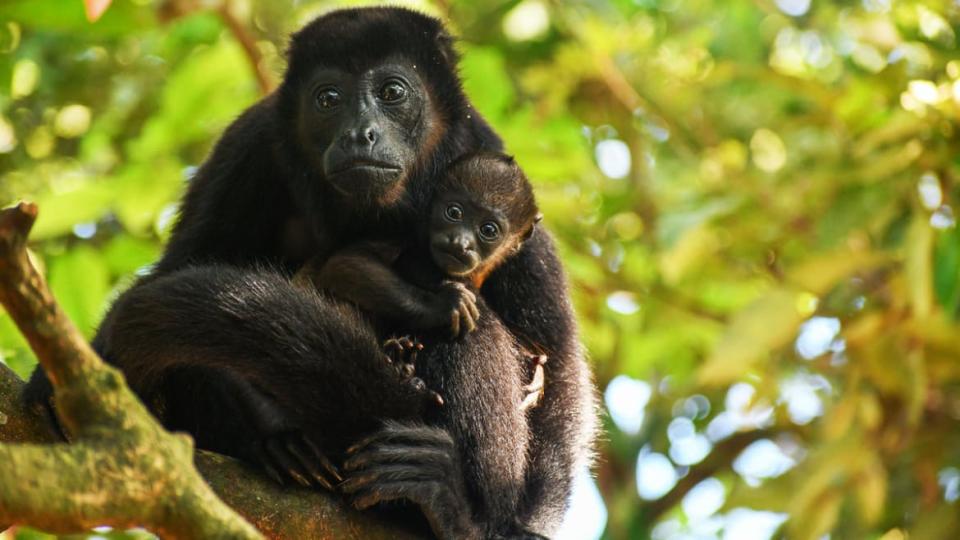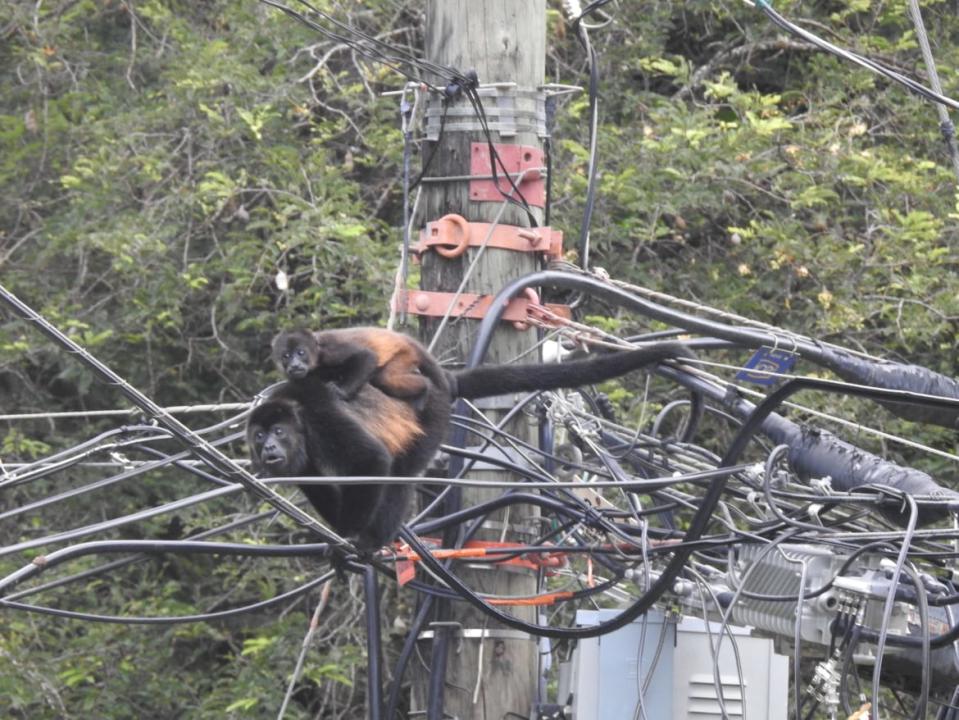As the Rich Swarm Costa Rica, Thousands of Monkeys Are Being Electrocuted

Down past the mango fields, past the river and pock-marked dirt roads, the town of Nosara occupies a dazzling portion of Costa Rica’s Pacific coast. Just north, at daybreak, thousands of baby sea turtles push through the sand and stagger their way to the ocean. The jungle teems with hummingbirds and coatis, peccaries and blue morphos and iguanas. Up in the branches, howler monkeys unleash roars that can be heard up to three miles away.
Paradise rarely gets left alone, and it’s no exception here. Once a quaint hideaway for yogis and surfers, Nosara has steadily beckoned more visitors, each cohort seemingly richer than the last. The pandemic accelerated that trajectory. Rental prices in sought-after areas have nearly doubled, locals say, while mega-mansions are selling for $7 million or more.
One casualty of that explosion is the wildlife that inspired much of the region’s popularity to begin with. Howler monkeys are suffering particularly gruesome deaths, from dog attacks, car accidents, and electrocutions caused by uninsulated power lines.
Because of dwindling habitat, “they’re forced to travel either on the ground, where they're vulnerable, or on the power lines, where they get killed,” said Robin Heubel, a retired wildlife biologist who now lives in the area. The electrocutions could largely be prevented by spending a few hundred dollars to insulate each transformer—and a few thousand dollars for every several hundred yards of cable—but nobody is putting up enough money to do it.
Depending on whom you ask, multiple parties are to blame: the power companies, the government, the developers, the home buyers. Undoubtedly, though, the surge of foreign transplants is exacerbating the problem. “With every new building, there’s higher voltage needed, because people are now building two and three story homes,” said Vicki Coan, founder of the nearby Sibu Wildlife Sanctuary. “[And] they want them totally air conditioned.”
The result, she continued, is that “this has been the worst year ever of electrocutions.”
In Costa Rica, This Group Makes Sure Your Tourist Dollars Go to Real Locals
The issue extends beyond Nosara, both along the coast and deeper into the country. In Tamarindo, two hours north, tangles of wires line the streets, a testament to the town’s growing popularity but a perilous new reality for the monkeys.
It’s difficult to estimate the exact number killed each year. Francisco Sánchez Murillo, veterinary director for International Animal Rescue Costa Rica, said that a monkey is reported dead from electrocution roughly every three days along a portion of the coast in the northwestern province, where Nosara and Tamarindo are located. Many deaths go unreported, however, meaning that across the country the tally is likely many multiples higher. One 2020 report claimed that 7,154 animals were electrocuted “in a single year.”
To Coan, each death is a unique trauma. “The pain and the suffering, I internalize that,” she said. When people visit her sanctuary, she often asks them the same jarring prompt: “Have you ever touched a little outlet and you got a little shock and you scream[ed] and it hurt? Can you imagine hanging on to that until it melts your skin to the bone?’”
Recently, she said, she got a call about an electrocuted monkey. “Somebody’s saying, ‘Yeah, his hand’s on fire and it melted and then [he] dropped’… Unless it’s super-high voltage, that death is not instant.”
Added Sánchez Murillo, of the brutal injuries, “It’s been my nightmare for the last six years.”

Settled by the indigenous Chorotega people, the area around Nosara was later overtaken by Spanish colonizers. Around the early 1970s, a new outsider arrived: an American investor who acquired a huge swath of land, with plans to create a golf course and residential community. The plan failed, but other development continued. The first road was constructed in 1979, and electricity followed closely behind.
Coan first visited in the 1990s. While driving, she recalled, “I heard the howlers, and I said ‘Stop the car.’ I got up kind of on the roof.” Howler monkeys are among the loudest land animals on the planet, and immediately, she said, “I was mesmerized.”
At the time, Nosara was idyllic. “It was a diamond in the rough back then. It was just an amazing place. You had this pristine 7km [5-mile] sand beach and gentle waves, and you had jungle and then maybe a small little B&B.”
By the mid-2000s, the town had become a destination. The New York Times named Nosara one of 45 places to visit in 2012, and from there, tourism increased dramatically, multiple residents said. The pace hasn’t slowed.
The attention brought much-needed tourism dollars, but also major drawbacks. Rent prices have risen both for locals and expats. And many of the newcomers have a taste for luxury. They install giant panes of glass in their homes to enjoy the jungle views, Coan said; the bright lights disturb nocturnal hunters and interrupt animal sleep patterns.
Meanwhile, homebuilders and property investors are cutting down trees, sometimes flouting permit requirements. “It’s like everybody is on this bandwagon to make as much money as they can as fast as they can, with no regard to the environment,” she said.
When the trees disappear, the monkeys become more vulnerable. Howlers consume enormous quantities of leaves, requiring them to stay on the move. According to Heubel, they learn routes to food sources from older generations. When the routes disappear, they often take to the power lines.
Visiting This Little Country Won’t Destroy the World
Nathaniel Jackson, a sales associate at Sotheby’s International Realty in Nosara, offered a softer take on residents, arguing that newcomers and builders generally seek to protect the environment.
“This is a biodiverse area, so competition between people and the planet is always going to be an issue,” he said. But he noted that residents had previously donated funds to insulate power lines—after the government and electric companies did not—and even formed an activist group to prevent electrocutions.
The town civic association also seeks to enforce responsible construction, he said, while most expats view environmental protection as the top of their “priority list in regards to why they even moved here in the first place.”
“People that came to this area 20 years ago, sure, they'll say that Nosara is busy,” he said. “But in reality, when you look at this area compared to, say, Tamarindo… Nosara has so much more protected area.
A spokesperson for Costa Rica’s Ministry of Environment and Energy sent The Daily Beast information about ongoing efforts to address the electrocutions, including establishing a working group between civil society, the ministry, and power distribution companies.
Despite those stated efforts, the problem clearly persists. If a monkey gets electrocuted, the troop will wait a week, then may try to cross at the same point, said Inés Azofeifa Rojas, field director of the nonprofit wildlife protection group SalveMonos. “They know that it’s a risk,” she said. But they need to eat.

According to Sánchez Murillo, between 80 percent and 85 percent of electrocuted monkeys die on the spot. Of the small fraction that make it to a rescue center, another third will succumb to their wounds. “Sadly, [sometimes] they stay with us for even months… and then they just crash months later from the trauma.”
Sánchez Murillo has witnessed the horrifying electrocutions in person. In some cases, “the monkey starts screaming in pain,” he said. “And the problem is that sometimes the troop, their family, tries to go and help,” which only results in more casualties.
The death count may also rise when a troop’s alpha male is killed, Sánchez Murillo said. A new leader will join the group and will likely kill the infants of the fallen male in order to establish its own genetic line. Consequently, “just one animal getting electrocuted could develop into a lot more getting killed,” he said.
There are a variety of proposals for keeping the monkeys safe. Azofeifa Rojas endorses placing power cables underground, a costly but highly effective approach. In cases where that isn’t possible, insulation and artificial crossings known as “monkey bridges” can provide a more secure route.
Coan believes that power companies should have a “mandatory responsibility” to insulate transformers and wires, arguing that they incur higher costs anyway when electrocuted monkeys blow out power lines. Activists are working on proposed legislation that would require companies to take protective measures, however some people are skeptical the government will act. In fact, said Elena Echandi—who holds a master’s degree in sustainable development—the current administration is working to relax certain regulations intended to protect the environment.
For the moment, much of the onus is on corporations and individuals. Last year, Heubel said, a power company in Nosara insulated dozens of transformers near Pelada beach, at least in part because of local pressure. “I need to give some credit where credit is due,” she said. But she has heard that “now they’re putting up new transformers and new lines [to] residences, and they’re not insulating them.”
Ironically, she pointed out, Costa Rica produces virtually all of its electricity from clean energy sources, “then they deliver it in a way that is potentially horrifying.”
The question becomes who should pay to make infrastructure more safe. Some propose incorporating the cost into consumers’ energy bills, though electricity rates are already unaffordable for many. Others suggest higher taxes on tourism or construction.
At a minimum, activists say, rich expats should ensure their homes are powered responsibly. Often, “it’s a couple hundred dollars, which is a drop in the bucket,” said Heubel. “My hope is that there's a lot of people who just are uninformed, as opposed to people who don’t care.”
To Coan, the mansions and excess in Nosara represent a destructive form of negligence: People are attracted to the town for its rustic tranquility, and yet they are rapidly upending it. “They don’t realize you can’t take what [you] left in the city to enjoy the beauty and nature here. Don’t bring that with you,” she said. “Leave it there and leave this here.”
Got a tip? Send it to The Daily Beast here
Get the Daily Beast's biggest scoops and scandals delivered right to your inbox. Sign up now.
Stay informed and gain unlimited access to the Daily Beast's unmatched reporting. Subscribe now.

